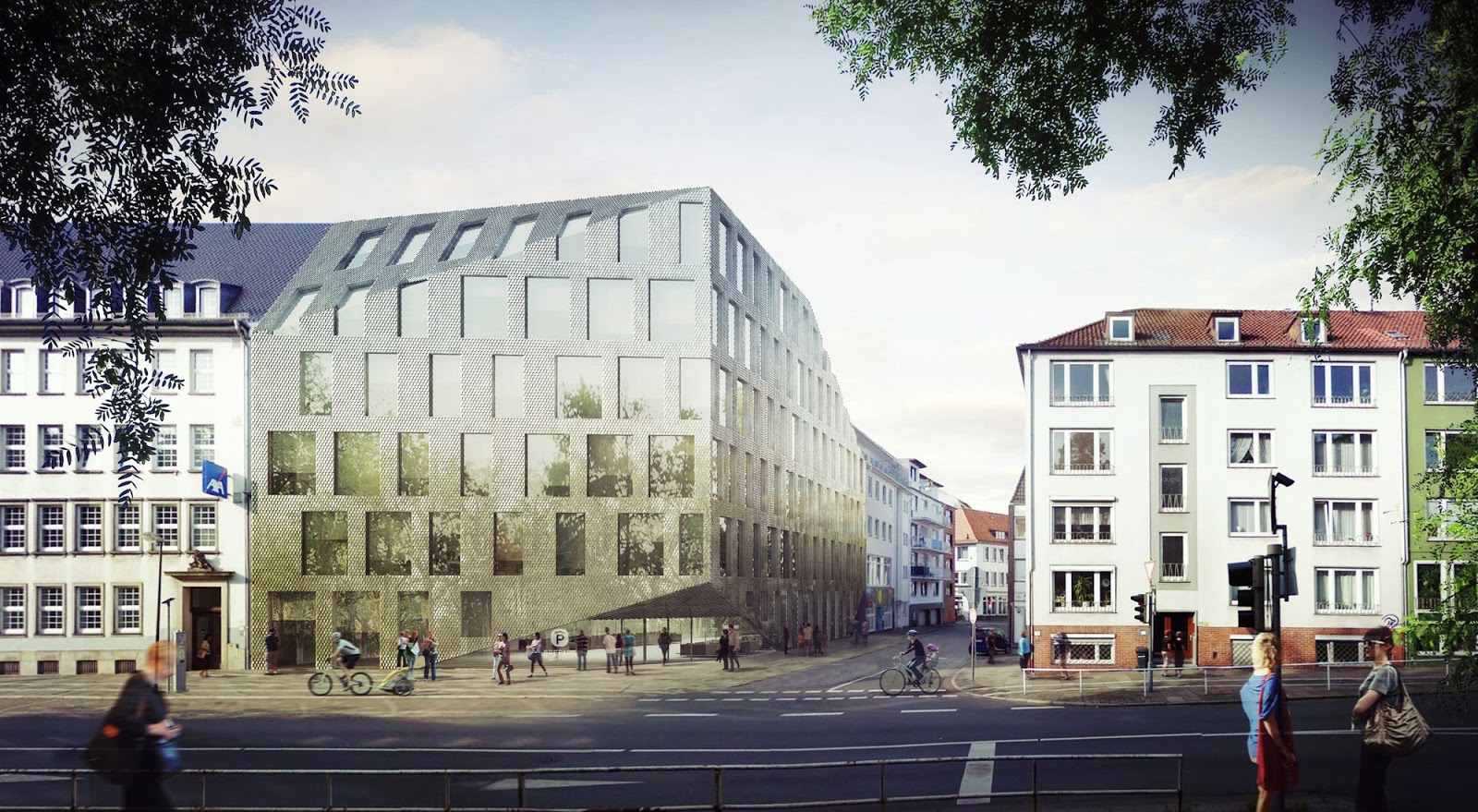Our proposal is to maximize the useable area of the building while producing a massing which plays a contemporary, unstable massing with the traditional massing, scale and fenestration in St Stephan’s Viertel: an urban block with a pitch roof and a repetitive series of vertical windows.
Functionality / program performance
The traditional window pattern and the use of masonry is ideal in terms of achieving the highest environmental performance standard. The window area has been set to be around 50% of the total surface in order to have sufficient area with a very high insulation value. The glazing content to the courtyard is reduced to less than 25% of office floor behind in order to control solar gain.
The volume is very compact, which helps both in terms of optimizing the volume but also in terms of energy performance and economy.
The entrances on the ground level and the contact with neighboring building are used as a way of distorting the grounding and the skyline of the building.
Urban integration
We are using the traditional massing in St Stephan’s Viertel: an urban block with a pitch roof and a repetitive pattern of vertical windows.
The materiality that we are exploring uses also clinker brick, with a slightly reflective enamel. The bricks have been laid out with a pattern that contributes to provide a delicate finish while remaining within a traditional palette of materials. The heavy ceramic wall will act not only as a thermal mass to stabilize the building’s temperature through all seasons, but also to absorb solar radiation and cold before it is transferred to the insulated membrane. The 50mm air cavity located behind the ceramic wall acts as a thermal break, and as a pressure equalization chamber, which improves the waterproofing capacity of the wall.
Interior design
The interior design of the building has aimed at retaining maximum flexibility for the end user. Both the plan and the façade has been designed on a grid of 1,35m, in order to fit the standards of employment space in Germany. The 16m wide plan is basically structured in three bays, two external ones of 4,5m deep to host cellular offices, and a column-free interior one for common spaces and clerical workers, which is approximately 7m wide. This layout corresponds quite precisely to the standard Kombi Type.
The vertical circulation core has been located in the area of the plan which has less availability of daylight: the inner corner. This will allow the offices to optimize the daylight within the given plan.
Outer shape / design
The geometry of the building envelope has been defined in a very direct manner, by simply extruding the available footprint to the maximum available height, to the cornice of the adjacent building along Am Wall Avenue.
After extruding the project to the maximum available volume, we have chiseled the volume in order to adjust the roof to the neighboring buildings, and to identify formally the ground level entrances. The result of these geometrical operations is an abstract volume which, while adjusting to the surroundings in terms of massing strategy, it has a remarkable lightness and beauty.
The cladding of the building is made with a series of prefabricated elements composed out of assembled bricks, with a three-dimensional pattern, which produces an additional vibration to the external surface, a delicate play of light and shadow.
Economy
The construction system of the building has been designed to be built economically and efficiently but also to have a low maintenance.
The structural frame of the project is proposed to be made in reinforced concrete with 300mm solid concrete slabs and an 8,1 x 8.1 m column grid. Some special frames will be needed punctually, on the roof level and on the entrance level. Solid concrete mass will be used to produce overnight cooling, and as a thermal mass during the day, as we will leave them exposed to optimize the benefits of thermal mass.
The façade, which has been designed to perform as a passivhouse, will be built as an insulated curtain wall with a 200mm insulation WLG024, and a U-Value of 0,15W/m2K. The external cladding will be built with panels made with bricks, on a modulation of 1,35 x 4,20 m. Glazing panes have all been specified with triple glazing. They have been designed on the same grid of 1,35 x 4,20 m. This type of construction for the envelope will ensure a very high quality, and a very fast construction process, as the façade will be fully unitized.
Sustainability
The building has been designed to perform as carbon neutral.
Our concept to achieve this in an office building with high demands on comfort was developed right from the outset of the design.
Fresh air is pre-conditioned in a subterranean geothermal labyrinth between the double parking bays and distributed throughout the building via hollow concrete slabs.
In addition, geothermal probes, each 100m deep, produce 100% of the heating energy used in winter and 100% of the cooling energy required in Summer. This energy is released via convector grilles in the floor along the windows.
All windows are fitted with an automatic external raffstore-shading system that avoids direct sun during the summer months but allows solar gain during winter.
No additional heating or cooling plant is provided.
The initial investment is offset by future savings due to minimal energy consumption.
The alternative energy resources used allow for a highly comfortable office environment with large, fixed glazing windows with openable air hatch for night-cooling, individual climatic control of different areas and natural daylight throughout.
AZPML Team: Alejandro Zaera-Polo, Maider Llaguno, Guillermo Fernandez-Abascal, Manuel Eijo, Pablo de Sola, Estela Arbesu, Davide Macchi
STUDIO WITT: Jan Pietje Witt
Renders: SBDA
Model: BOJE MODELLBAU
Client: BrePark GmbH
Place: Bremen, Germany
Competition: 2014
Area: 3 500m2
Cost: 7,5M €



.png)
.png)
.png)
.png)
.png)
.png)
.png)
.png)
.png)
.jpg)
